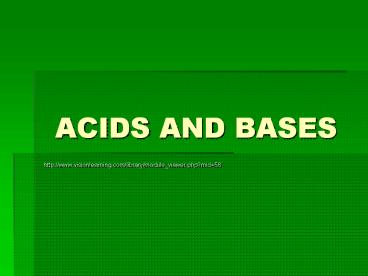ACIDS AND BASES - PowerPoint PPT Presentation
1 / 25
Title: ACIDS AND BASES
1
ACIDS AND BASES
- http//www.visionlearning.com/library/module_viewe
r.php?mid58
2
ACIDS
- The term acid comes from the Latin terms acere,
which means "sour and acidus, which means
sharp. - Acids taste sour, are corrosive to metals, change
litmus (a dye extracted from lichens) red, and
become less acidic when mixed with bases. - Acids are compounds that contain hydrogen and can
dissolve in water to release hydrogen ions into
solution. - HCl H20? H(aq) Cl-(aq)
3
(No Transcript)
4
BASES
- Bases feel slippery, change litmus blue, and
become less basic when mixed with acids. - Another word for base is ALKALI. Where have we
heard that before??? - Bases are substances that dissolve in water to
release hydroxide ions (OH-) into solution. - NaOH H20? Na(aq) OH-(aq)
5
NEUTRALIZATION
- As you can see from the equations, acids release
H into solution and bases release OH-. If we
were to mix an acid and base together, the H ion
would combine with the OH- ion to make the
molecule H2O, or plain water (neutral substance) - H(aq) OH-(aq) ? H2O
6
- The neutralization reaction of an acid with a
base will always produce water and a salt, as
shown below - Acid Base ? Water Salt
- HCl NaOH ? H2O NaCl
- HBr KOH ? H2O KBr
7
PREDICT ACID OR BASE?
- Lemons/limes
ACID
8
- Pickles
ACID
9
- Baking soda (NaHCO3)
BASE
10
- Hand soap
BASE
11
- Ammonia (NH3)
BASE
12
- Tums
BASE
13
- Coffee
ACID
14
- Apple juice
ACID
15
- Drain cleaner
BASE
16
- Tomatoes
ACID
17
- Glass cleaner
BASE
18
- Normal rain water
SLIGHTLY ACIDIC
19
- Water (H2O)
NEUTRAL
20
How do we measure how acidic or basic something
is?
- Both acids and bases are related to the
concentration of hydrogen ions present. - Acids increase the concentration of hydrogen
ions, while bases decrease the concentration of
hydrogen ions (by accepting them to form H2O). - The acidity or basicity of something therefore
can be measured by its hydrogen ion
concentration. - This is done with the pH scale.
21
The pH scale is described by the formula
- pH -log H
- Note concentration is commonly abbreviated by
using square brackets, thus, H hydrogen ion
concentration. When measuring pH, H is in
units of moles of H per liter of solution.
22
What does THAT mean?
- For example, a solution with
- H 1 x 10-7 moles/liter has a pH equal to 7
(a simpler way to think about pH is that it
equals the exponent on the H concentration,
ignoring the minus sign). - H 1 x 10-7 plugged into the equation is
- -log 1 x 10-7 -log10 -7 -(-7) 7
23
Measuring pH
- The pH scale ranges from 0 to 14.
- Substances with a pH between 0 and less than 7
are acids (pH and H are inversely related -
lower pH means higher H). - Substances with a pH greater than 7 and up to 14
are bases (higher pH means lower H). Right in
the middle, at pH 7, are neutral substances,
for example, pure water.
24
The pH scale
25
What is the pH? Is it acid/base/neutral?
- -log 1 x 10-9
- -log 1 x 10-7
- H 1 x 10-3
- H 1 x 10-13
base
pH 9
neutral
pH 7
pH 3
acid
base
pH 13































